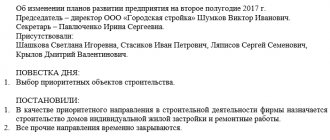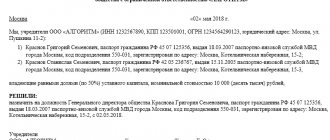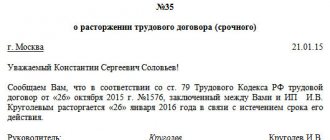Drawing up minutes of the general meeting of the workforce is necessary to register actions at general corporate meetings. The reason for such events can be completely different circumstances:
- selection of candidates for presentation at various conferences, seminars, congresses,
- approval of some internal documents, acts,
- amendments to collective agreements,
- summarizing the results of work or familiarization with the company’s development strategy, etc.
FILES
Typically, such meetings are held in large organizations with an extensive network of structural units and a large number of employees. Small businesses, as a rule, do without such formalities.
Why are general meetings needed and why document them?
A work collective is not just a certain number of employees of one enterprise interacting with each other and external entities to achieve common goals. This is a separate body, which, like the management of the company and its administrative part, is endowed with certain powers. In order for the team to make a decision on any pressing issue, it is necessary to gather it in one place and bring this issue up for discussion.
It should be noted that the topic of the meeting can concern either one problem or several at once.
General meetings make it possible to build a vertical connection between ordinary employees of an enterprise and its management, ensure prompt resolution of acute external and internal corporate problems and labor disputes, create and approve regulations and documents, as well as resolve any other pressing issues.
The role of the minutes in this process is also quite clear and simple: it consistently records everything that happens at the meeting to reflect in writing the opinions or decisions of its participants. As a result, in the future this document serves as the basis for the company’s management when taking any measures, developing documents, etc. actions.
Protocol structure and plan
The minutes of the general meeting of the labor collective includes an introductory and main part . A constituent element of the protocol may also be the dissenting opinion of an individual participant.
In contrast to this opinion, the mandatory details of the protocol are parts of the document, without which it has no legal force.
Required details
Mandatory details of any minutes of the general meeting of the labor collective are :
- full name of the organization;
- type of document (in our case this is a protocol );
- date of the meeting ( if the meeting took place over several days, the start and end dates are indicated with a dash );
- registration number;
- place of compilation;
- title to the text ( document details that briefly outline its content );
- signatures of the secretary and chairman of the meeting.
Introductory part
The elements of the introductory part of the protocol are:
- Full name of the secretary and chairman;
- Full name of meeting participants. Provided that their number is more than 15 people, only their number is recorded , and a complete list of participants indicating their last names and initials is attached to the protocol. In addition, the total number of employees of the organization is noted ;
- Full name of invited persons , if any, along with position and place of work;
- Agenda. Agenda items are arranged in order of decreasing importance . In addition to the questions, it is necessary to note the speakers for each of them .
Full information about each employee is in the employment contract. How to keep a journal of registration of employment contracts, sample - see the link.
Main part and extract
The main part of the protocol consists of sections . The content of each section must correspond to the issues on the agenda ( the first section is devoted to the first issue on the agenda, etc. ). The section plan includes the following elements:
- the first structural element begins with the word “Listen:...”. It indicates the name of the speaker and, as a rule, the title of the report . itself is attached to the protocol . However, the text of the report can be directly placed in this part of the protocol;
- the second element is introduced with the word “Spoken by:...” . The names of persons who asked questions to the speaker or otherwise participated in the discussion on the issue are reflected here. In addition, the essence of these questions and speeches is formulated ;
- the last part is introduced with the word “We decided:...”. It sets out the decision made. Below it is indicated the number of those who voted “for”, “against”, as well as those who abstained from voting .
In addition, a list of persons who did not take part in the vote must be attached. A decision on one issue may consist of more than one paragraph.
In this case, they are placed depending on the decrease in significance . The dissenting opinion of an individual participant is noted in the minutes after the decision to which it relates.
Many issues are resolved by the organization's accounting policies. Read about what it is in this article.
Extract from the protocol.
Procedure for holding the meeting
- A few days before the event, all employees of the team are notified of the appointed date for the general meeting. When notifying employees, it is advisable to briefly outline the topic of the event.
- At a predetermined time, workers gather in a designated place, and the chairman and secretary of the meeting must be present among them. The first usually manages the course of the event, the second records everything that happens in writing in a special protocol and counts votes during voting. Moreover, both of these people must be employees of the same organization whose staff meeting is being held and have a certain authority.
In most cases, the election of the chairman and secretary is carried out for a period of one year.
It should be noted that the meeting is considered to have taken place only when at least half of the company’s employees are present, and similarly, any issue is considered resolved only if more than half of those present have voted on it.
How to draw up a protocol
The minutes of a meeting of the labor collective (as well as the minutes of a trade union meeting) on the adoption of a collective agreement have the following structure:
Introductory part. You must indicate your full name. chairman, secretary, number of participants.
Agenda. Here are the issues that will be considered at the meeting. Speakers for each individual issue are also noted.
“Listen” section. In this section, indicate your full name. speakers and the essence of the report.
Section "Spoken". Here they write down their full name. persons who asked questions to the speaker or took part in a discussion on the issue. The essence of the questions asked and speeches should also be displayed here.
Section "Decided". This part indicates what decision was made. Below it you must indicate the number of participants who voted “for” and “against”. If some participants abstained from voting, their number is also indicated.
At the end of the document the signatures of the secretary and the chairman must be affixed with a transcript.
A collective agreement is concluded for a period of up to 3 years. After it is signed by representatives of the employees and the employer, it comes into force. The signed collective agreement must be registered with the labor inspectorate.
Sometimes the employer and the workforce cannot agree on some points of the collective agreement. If such a situation arises, the contract is concluded on the terms that were approved. And on the remaining points they draw up a protocol of disagreements.
Sep 10, 2019adminlawsexp
Rules for drawing up a protocol
The minutes of the general meeting of the labor collective do not have a single unified template recommended for use, so they can be written in free form or according to a specific template developed at the enterprise and approved in its accounting policy. At the same time, there is a number of information that must be reflected in it, these are:
- name of company,
- number and date of compilation,
- number of full-time and freelance workers,
- number of people present,
- information about the meeting chairman and secretary.
The minutes record the entire sequence of events occurring at the meeting, including the issues put on the agenda and the results of voting on them (if such voting took place).
The minutes can be very detailed, or maybe quite condensed, recording only the main points of the meeting - there are no rules here.
If necessary, some additional annexes may be attached to the minutes that are directly related to the issues discussed at the meeting - information about them should also be reflected in the main text of the document.
Information for the document
The preparation of the minutes of the meeting of the labor collective is carried out on the basis of the Labor Code of the Russian Federation, namely section 2, part 2, Social partnership in the sphere of labor of the Labor Code of the Russian Federation.
Features of document preparation
Contents of the protocol
The minutes of a meeting of the labor collective is a procedural document and must contain the following data:
- Date, time and place of its compilation.
- The topic for which a meeting of the organization’s employees was convened to discuss.
- Information about the chairman of the meeting and the secretary who keeps its minutes, as well as the procedure for their election, that is, the number of people who voted “for” and “against” their election.
- Information about the total number of persons present, and the total number of employees of the organization, to determine the possibility of holding a meeting.
- The decision made by voting, as well as the number of votes voted “for” and “against” its adoption.
- Signatures of the secretary, recorder and chairman of the meeting.
If several topics are discussed at a meeting, each of them and the vote on its consideration are indicated separately.
A proposal to start collective negotiations can be sent to the employer in advance by a representative of a trade union organization - Art. 37 Labor Code of the Russian Federation.
Expert opinion
Lebedev Sergey Fedorovich
Practitioner lawyer with 7 years of experience. Specialization: civil law. Extensive experience in defense in court.
Important! When resolving collective labor disputes, copies of the demands of trade union organizations can also be sent to the state body responsible for resolving collective labor disputes - Art. 399 Labor Code of the Russian Federation.
This is important to know: Military discipline, rewards and disciplinary sanctions
According to Art. 384 of the Labor Code of the Russian Federation, at the initiative of workers, commissions for the settlement of labor disputes can be created. Such commissions can consider individual labor disputes within the powers of these divisions.
The commission has its own seal, and organizational and technical support for its activities is provided by the employer. The commission elects from among its members a chairman, deputy chairman and secretary of the commission - Art. 384 Labor Code of the Russian Federation.
Protocol Features
The actions of the parties to a collective labor dispute, agreements and decisions made in connection with the consideration and resolution of this dispute are documented in protocols by representatives of the parties to the collective labor dispute, conciliation bodies or the body leading the strike - Art. 418 Labor Code of the Russian Federation.
A general meeting of employees can be recognized as legal only if more than 50% of the total number of employees of the enterprise are present, or if there are at least 30% of delegates elected by the employees of the enterprise - Art. 399 Labor Code of the Russian Federation.
Representatives of workers in social partnership are: trade unions and their associations, other trade union organizations provided for by the charters of all-Russian, interregional trade unions, or other representatives elected by workers in cases provided for by the Labor Code of the Russian Federation - Art. 29 Labor Code of the Russian Federation.
The interests of workers are represented by the primary trade union organization, or by representatives elected by the workers themselves. In addition, if the issues under consideration relate to the conclusion, resolution and amendment of a collective agreement, as well as monitoring their implementation, the interests of workers can be represented by a trade union, its territorial organization or an association of a territorial organization of trade unions - Art. 29 Labor Code of the Russian Federation.
Representatives of an organization who evade participation in conciliation procedures, including those who refuse to provide premises for holding a general meeting of employees of the enterprise, may be subject to disciplinary and administrative liability - Art. 416 Labor Code of the Russian Federation.
Rules for drawing up the protocol
The protocol can be drawn up in any form: on a simple standard A4 sheet or on the organization’s letterhead, both printed and handwritten. The main condition: it must contain “live” autographs of the chairman of the meeting and the secretary, which thus certify the fact that all the information entered into it is correct. The document can be certified by a seal, but it is not necessary, because from 2020, legal entities, as previously and individual entrepreneurs, are exempt by law from the requirement to use seals and stamps when endorsing papers.
The protocol is drawn up in one copy , which, after losing its relevance, is sent to the archive of the enterprise, where it remains for the period required by law, and then is disposed of.
Protocol Details
In the process of adopting a collective agreement, protocols are drawn up at different stages, differing in the content of the issues discussed and the decisions made. For example, the minutes of a trade union meeting on the adoption of a collective agreement may include questions about the need to conclude a collective agreement, about the approval of commission members - representatives of the trade union and employees, etc.
The document is endowed with legal force, and every decision recorded in it is binding.
The minutes are drawn up by the secretary. The prepared document is submitted for approval to the chairman of the meeting, and it is also signed by the secretary. The chairman and secretary are elected at the beginning of the meeting - usually the first item on the agenda.
The protocol is often drawn up on the organization’s letterhead. All pages in it must be numbered. The preparation of the protocol is carried out in three stages:
Preparatory actions are being carried out.
The secretary draws up the document.
All interested parties are familiarized with the protocol.
Sample minutes of a general meeting of the labor collective
- At the beginning, in the middle of the line, the full name of the company is written, then the name of the document and its number according to internal documentation.
- Below is the date of drawing up the protocol and the locality in which the enterprise operates.
- Next, the composition of the meeting is established: the total number of employees of the enterprise (in the state and outside the state) is recorded, and the number of those present is counted.
- Then information about the chairman of the meeting and the secretary is entered, their positions, surnames, first names and patronymics are indicated here.
- After this, an agenda is brought up for discussion, which is written verbatim into the minutes. If it is a vote (as in this example), the number of votes “for”, “against” and “abstain” for each item should be noted and the final result should then be recorded in the minutes, i.e. solution.
- Finally, the minutes must be signed by the chairman and secretary of the meeting with transcripts of the signatures.
Design nuances
The minutes of the meeting on the adoption of a collective agreement (the sample below can be used as a basis) must contain the following information:
- place, date and time of the meeting;
- agenda;
- list of issues to be discussed;
- FULL NAME. chairman and secretary;
- information about the number of people present;
- data from speakers and proposals made by them;
- Voting results;
- approved decisions.
You can familiarize interested parties with the text of the document in the following ways:
- by sending them copies of the protocol;
- by posting an extract from the document on a stand in the organization’s lobby.
Minutes of the collective agreement meeting sample 2020 free download
application no. 7
general meeting of employees
PROTOCOL
dated April 30, 2020 No. 6 on approval of the collective agreement
Chairman of the meeting - Vitaliy Viktorovich Zuev, deputy. director of legal education.
The secretary of the meeting is Semenova Inessa Evgenievna, chairman of trade union committee No. 67, teacher of history and social studies.
1. Approval of the collective agreement of MBOU “Secondary School No. 78” for the period from 2013 to 2020
Semenova I.E.: Work on signing a new collective agreement was carried out systematically. In February, according to the order, a commission was created for the school consisting of Kondratenko A.P., Semenova I.E., Afanasyeva M.V., Pavlov V.S., Gmerina T.S. The commission studied all the proposals and recommendations of the team to amend the current collective agreement. Two meetings of the conciliation commission were held. As a result, the parties came to an agreement. There are no controversial issues. The collective agreement was presented to the team for review (period of 1 month). The text of the collective agreement and its annexes could be found in the school library. No comments were received. I would like to note that the commission worked in good faith.









